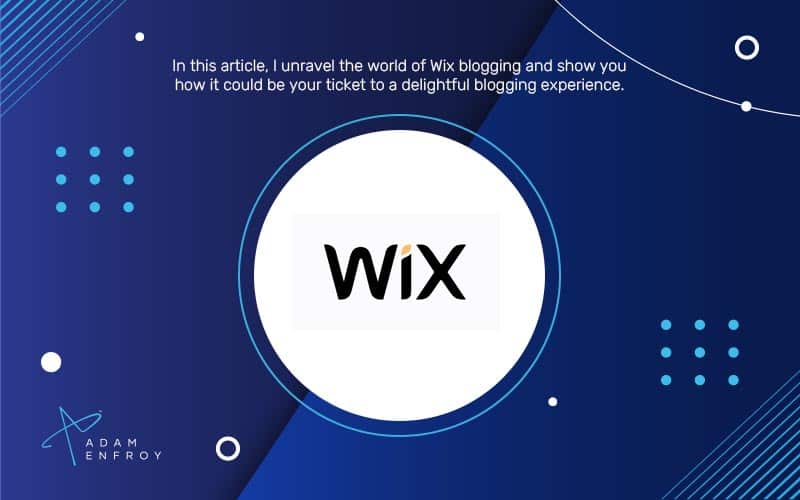Using Sales Copywriting For Business Success In 2024
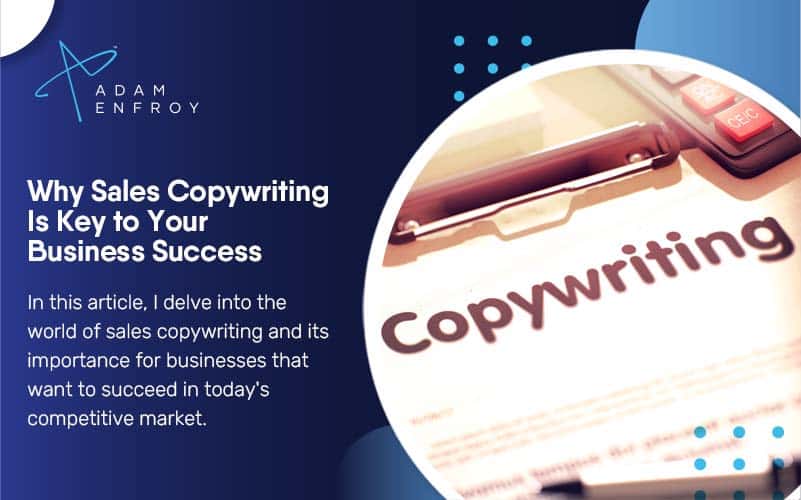
Imagine you could use the right words to create persuasive sales copy and get people to take the desired action.
How much would that skill be worth to you?
In today’s world, you can craft powerful sales messages by combining AI copywriting software and your brain as a creative force.
In this article, I’ll provide some tips and tricks for writing powerful sales copy that will help you increase your conversions, boost your profits and run a better all-around business.
The Power of Psychology in Your Sales Copywriting
Many business owners understand how powerful even just one simple idea can be in helping them communicate effectively.
Becoming better in this area means understanding the fundamentals of psychology and its effects on customers.
How someone perceives your product or service is essential.
Writing compelling sales copy is both an art form and a science, requiring creativity and a good understanding of psychology.
When you understand how people think, you can tailor your words to evoke specific emotions and reactions from potential customers.
Whether you’re doing content marketing, email marketing, or other types of writing, deeply understanding your audience is critical.
You need to know what speaks to them, what resonates with them, and what will interest them enough to learn more about your product or service.
Understanding their needs and motivations will help you write clear messages that drive them to action.
How scarcity and urgency fit in
As a content creator, understanding your potential customers’ thought processes can significantly impact conversion rates.
Two of the most effective psychological techniques used in marketing are “scarcity” and “urgency.
Scarcity refers to making customers aware of limited availability or time-sensitive offers and ranges from a “limited-time offer” to a “low stock warning”.
Urgency emphasizes the importance of action to get the best possible results.
Urgency can be created by using words like “now”, “today”, and “last chance”.
This technique creates a sense that something is limited or hard to get, making people feel compelled to act before it’s too late.
For example, if you were selling tickets for a popular event, you might emphasize that only a few tickets are left.
You could also explain that customers must purchase tickets by a specific date to secure their spot.
Questions and stories
Another way to use psychology in marketing is by kindling interest through questions and stories.
Asking questions encourages readers to think about their experiences and challenges related to your product or service, which helps establish an emotional connection with them.
Similarly, stories have been proven time and time again as one of the most powerful tools for engaging readers.
They provide insight into your company’s identity while providing valuable information about your product or service.
Using Controversy
Creating controversy or stirring guilt to encourage people to act can be another method to consider.
While many hesitate to use such a tactic, if you come from wanting to help your readers, then using controversy and guilt can be effective.
For example, if your company has a solution to environmental problems, highlight the planet’s current state or mention people’s guilt when they don’t do something to help.
Controversial headlines often grab attention because they challenge existing beliefs or ideas.
However, use the technique cautiously, as it can backfire if not done correctly.
Similarly, stirring feelings of guilt can also motivate customers to take action.
Building on the environmental example above, describing someone casually butting their cigarette out in the street could evoke guilt and encourage people to do their part for the environment.
Ultimately, it is essential to remember that both approaches should be balanced when crafting content around controversial topics or guilt-evoking imagery.
Knowing who your target audience is is essential when writing compelling sales copy.
Different audiences respond differently based on their age group, culture, gender, etc.
It’s vital to tailor your message to who they are as people.
Understanding their needs before you start writing will help ensure that your message resonates with them emotionally and that they feel compelled to take action.
Proven Copywriting Formulas
There are various tried and tested copywriting formulas that you can use to create engaging sales copy that resonates with your target audience.
These include the:
- AIDA formula (Attention, Interest, Desire, Action)
- PAS Formula (Problem-Agitate-Solution)
- Before-After-Bridge
- ACCA Formula (Awareness – Comprehension – Conviction – Action)
- And more.
Let’s explore the above in more detail.
The AIDA formula
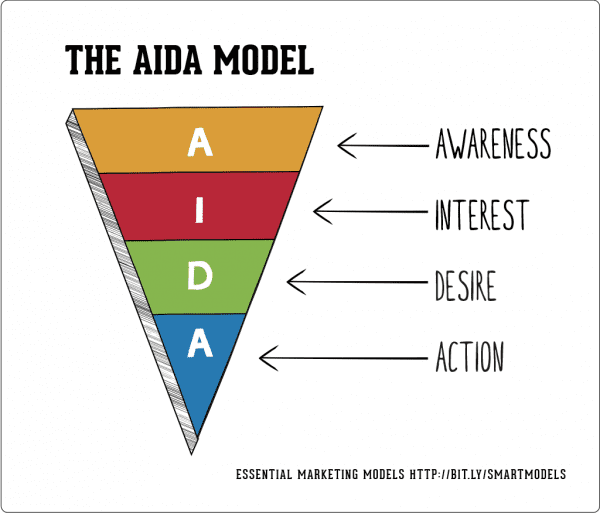
Source: Smartinsights.com
Writing sales copy that stands out becomes more straightforward using the AIDA formula.
AIDA stands for Attention, Interest, Desire, and Action, which can help generate sales copy that resonates with your target audience.
To hone in on buyer personas and create copy that resonates with them, you must identify their pain points, offer solutions to their problems, and demonstrate how your product or service will benefit them.
So how do you use the AIDA formula to create copy that not only grabs the attention of your target audience but provides a tangible solution or benefit?
Let’s break down these components one by one starting with Attention.
You need to capture your readers’ attention with an eye-catching headline or subject line so they will continue reading your sales page or email.
The headline should be short, catchy, relevant to the product/service you are selling, and convey a benefit potential customers can gain from using it.
Next comes Interest, where you share stories of success – whether personal or corporate – that show how your product/service has helped others.
Doing so helps build trust among potential customers because it shows that there are real people out there who have been able to benefit from what you are offering.
The third component of the AIDA Formula is Desire which requires you to outline all of the specific benefits your product/service offers in bullet points so readers can easily digest this information quickly.
This section should also include information about why customers should choose your product/service over competitors.
Include any special offers or discounts at the time being offered for additional incentives, making it easier for people to purchase from you instead of someone else.
Finally comes Action.
Action encourages readers to purchase, sign up for more information, or do whatever else you want them to.
Providing clear calls-to-action and an easy way for customers to contact you with any questions helps make it easier for them to decide.
At the same time, they won’t feel overwhelmed or confused by too much information all at once.
The PAS Formula
Another powerful and proven formula for creating persuasive sales copy in digital marketing is the PAS Formula, which stands for Problem-Agitate-Solution.
Whether copywriters want to increase ecommerce conversions, establish brand recognition, or build trust with their customers, the PAS formula can help.
This framework can also help sharpen one’s copywriting skills and help one create persuasive, attention-grabbing content, forcing one to break a problem down into three clear phases.
With the PAS formula used to connect with potential customers through their pain points, the copywriter can create content that resonates with the customer on an emotional level.
This formula consists of three parts: Problem, Agitate, and Solution.
The first step in this process is identifying the problem that your product or service can solve.
You want to make sure you are speaking directly to the needs and wants of potential customers by outlining what problems they may be facing.
Whether finding a job or feeling overwhelmed by all the options available when choosing a new car, really bringing out that problem is crucial.
Once you’ve identified the problem, the next step is to agitate it by highlighting how much worse it would be if they took no action toward solving it.
This part should also include stories of people who have successfully used your product/service to solve their problems and how it has improved their lives.
You could create a sense of urgency that encourages readers to take action sooner rather than later.
Finally comes the solution, where you explain in detail how your product or service can help them solve their problem.
You want to ensure you include all the features and advantages of using your solution, so potential customers know what they will get for their money and why it’s worth investing in your answer.
Remember that each element should be clear, concise, and engaging when creating a persuasive copy with the PAS formula.
Before-After-Bridge Formula
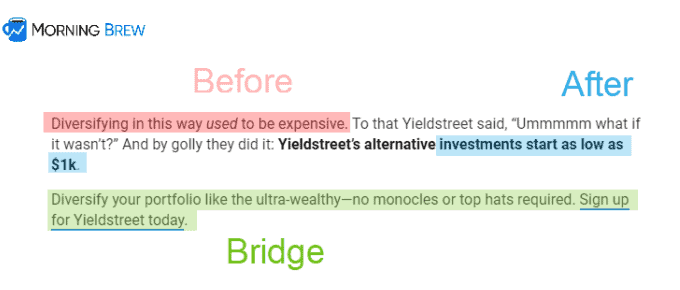
Image credit: https://twitter.com/MorningBrew
The Before-After-Bridge (BAB) formula is a powerful copywriting tool used to create vivid before and after pictures in the minds of potential customers.
This method involves outlining customers’ lives before they found your product or service, how it has drastically improved their lives since then, and finally, the bridge which explains why your solution is the best choice for them.
Using the BAB for persuasive copywriting can help build trust and strengthen relationships with potential customers.
The first step in this process is to paint a clear picture of customers’ life before they find you.
You want to make sure you include all of the struggles and frustrations they faced daily so readers can relate to their efforts on a personal level.
The second component is where you explain how your product or service has improved their lives and made it easier for them to do whatever they need.
This section should include stories of past customers’ benefits from using your solution.
The final step in the BAB formula is the bridge which explains why your product/service was the best choice.
Some examples of this could be unique features that make it different from competitors, unbeatable customer service, or anything else that sets you apart from other options and makes customers’ decisions a no-brainer.
ACCA Formula
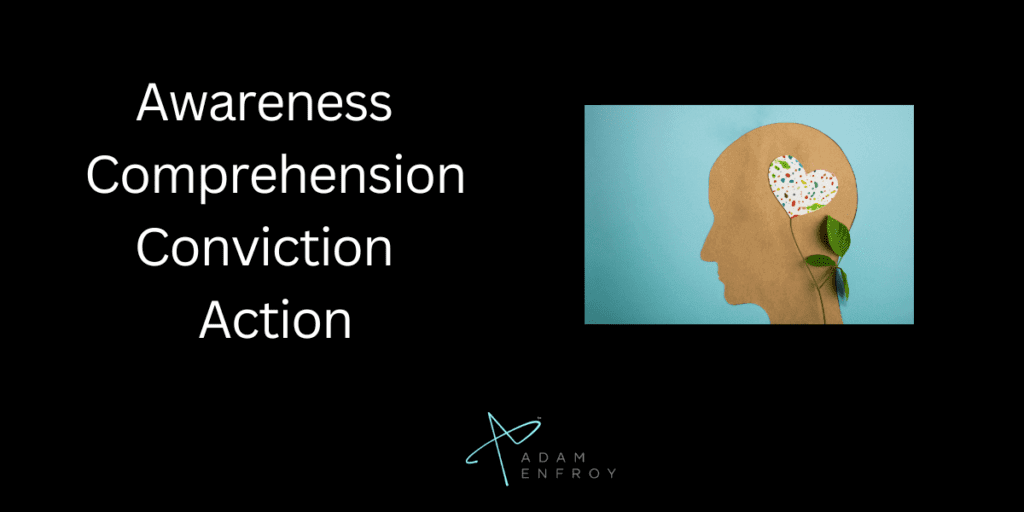
The Awareness – Comprehension – Conviction – Action (ACCA) formula makes writing sales copy more straightforward.
Copywriters can use it effectively in many situations, including an online store looking to create product descriptions for web pages that sell items.
Let’s consider that one is creating product descriptions for web pages that sell shoes.
The first step is creating awareness about the product.
Information about the shoe brand, type of material used, and design should be included to give readers a good understanding of what to expect when purchasing.
The second component is comprehension, clarifying what makes these shoes stand out.
You can explore superior comfort, cutting-edge technology, or any other unique features these shoes have that others don’t.
The third step is conviction, where the sales copywriter should explain why customers must have these shoes and how buying them will benefit their lives.
Include stories of other customers’ experiences or a simple explanation of why it’s worth investing in these shoes over others.
Finally comes the Action, where the sales copywriter should encourage customers to buy the shoes.
Offer special discounts or limited-time offers that make buying a no-brainer.
Using the ACCA formula, copywriters can write sales copy that grabs potential buyers’ attention and persuades them to purchase their product.
How to Market Your Product By Selling Benefits, Not Features
People don’t want to know about the features of your product – they want to know how it will help them.
That’s why a small business must move away from offering product/service features and instead concentrate on the advantages its products can provide the ideal customer with.
Let’s explore the concept of selling benefits over features in more detail.
The Difference Between Benefits and Features
Understanding benefits and features can help businesses create focused, effective landing pages.
In copywriting, benefits are generally more critical than features.
At the very least, consider how such benefits align with your audiences’ emotions.
Let’s first define these terms.
Features are the physical characteristics of a product; they explain what your product/service can do and how it works.
Conversely, benefits explain why one should buy this product or service over others.
When marketing your product, it’s essential to understand the difference between benefits and features.
To illustrate this point with an example, let’s consider weight loss supplements.
The features might be organic ingredients, gluten-free, low-calorie, etc., but the benefit is improved health and confidence through achieving health goals with an all-natural solution.
Consider that sales copywriting is persuasive writing, and the goal is to get potential buyers interested in buying your product.
Focusing on what will make both new and existing customers buy from you is essential.
Said differently, those are the benefits, not the features.
Showcase Your Benefits Clearly
Once you have established which benefits each feature offers a potential customer, ensure these are showcased clearly on website copy and other marketing materials.
From social media posts to email campaigns, potential customers can easily see what they stand to gain by using your product or service.
Additionally, keep revisiting this process as new products enter the market, or new technologies become available.
If there’s an even better solution out there than yours, potential customers will find it.
Additionally, you can use customer feedback to identify differentiators, refine messaging, and inform the development of new features that would better fit what customers are looking for.
Again, even as you develop more features, focusing on the key benefits will be more beneficial in marketing and sales.
Ensure you clarify these points, so customers know what sets your product or service apart from the competition.
You can also use user-generated content to connect emotionally with potential buyers through the experience of others.
Having user-generated content is also a great way to add credibility and trustworthiness.
By leveraging customers’ voices and incorporating them into your marketing strategy, you can build an authentic connection with potential customers that will help drive sales.
Using specific action words in your copy can also help drive home the features and benefits of your product.
With such words, customers will understand your value proposition and what they can get from your product or service.
How to Write a Copy that Connects with Customers
Crafting high-quality copy that resonates with customers comes down to understanding your audience and their needs.
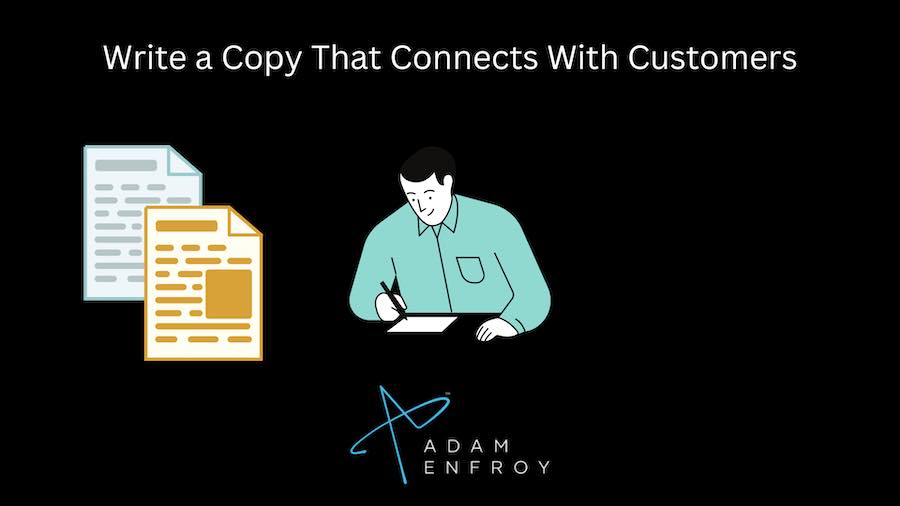
When writing sales emails, web copy, sales pages, or any other, the first step is to ditch the jargon and write in simple, natural language.
I’m not saying to dumb down your copy or use slang.
Instead, use words that anyone can understand without consulting a dictionary.
For example, rather than saying, “We offer a comprehensive suite of search engine optimization services,” you could say, “We can help you improve your rankings and get more traffic from Google.”
The second version is shorter, more precise, and more human.
Another way to make your copy more relatable is to write conversationally.
This means using contractions (we’re, you’ve, etc.), first-person pronouns (I, we), and even throwing in the occasional emoji or GIF.
Of course, you don’t want to go overboard with this approach—after all, you are trying to sound professional—but some informality can go a long way.
Stories are one of the most potent ways to connect with people on an emotional level.
When telling stories in your sales copy, make sure they are relevant to your selling and paint a picture of how your product or service can improve your readers’ lives.
For example, if you’re selling a weight loss program, you might tell the story of someone struggling to lose weight but finally reaching their goals after using it.
Telling stories humanizes your brand and helps potential customers see how you can help them solve their problems.
In addition to stories, images are also compelling when connecting with readers emotionally.
Using images of real people instead of stock photos is one way to give your copy an extra dose of personality.
Another approach is to use pictures specific to your niche or audience.
If you’re targeting stay-at-home moms, using images of mothers and children in your copy will resonate more than generic photos of women smiling at laptops.
The key is using images that align with your message and target audience for maximum impact.
How Great Copywriting and Analytics Can Help Increase Sales
As businesses get more insight into how customers react to specific copy, they can more effectively craft compelling content that leads to more sales.
Knowing the ROI statistics behind any sales funnel, you run can help determine what kind of copy works best for each stage.
Analytics can also help understand psychographics—the psychological traits that drive sales, making you better equipped to target customers personally and meaningfully.
Copywriting and analytics allow web page visitors to feel like they’re being spoken to directly.
By leveraging psychology and data-backed insights, businesses can create persuasive copy that turns prospects into customers and drives higher conversions.
Google Analytics and A/B testing
Google Analytics is a tool that allows you to track the performance of your website and its various pages.
You can see which of these get the most traffic and engagement and which don’t perform as well.
You’ll be able to identify which areas need more attention or updates to better engage with customers and boost sales.
Plus, you can also use Google Analytics to measure and report on the effectiveness of campaigns that you have run.
Whether using email copywriting to improve your marketing or running pay-per-click advertising campaigns, you can better plan future marketing strategies for maximum ROI.
A/B testing (also known as split testing) is another excellent way to measure the effectiveness of copywriting.
With A/B testing, you send people to two versions of a – one with the original copy (the “A” version) and one with the revised copy (the “B” version).
The two versions are tested against each other by sending half of the visitors to each page – whichever performs better is considered the winner.
Over time, this method gives you valuable insight into what kinds of copy your customers respond best to, leading to more effective marketing campaigns.
Other Key Copywriting Tips
Here are a few other copywriting tips to help you create compelling, engaging content.
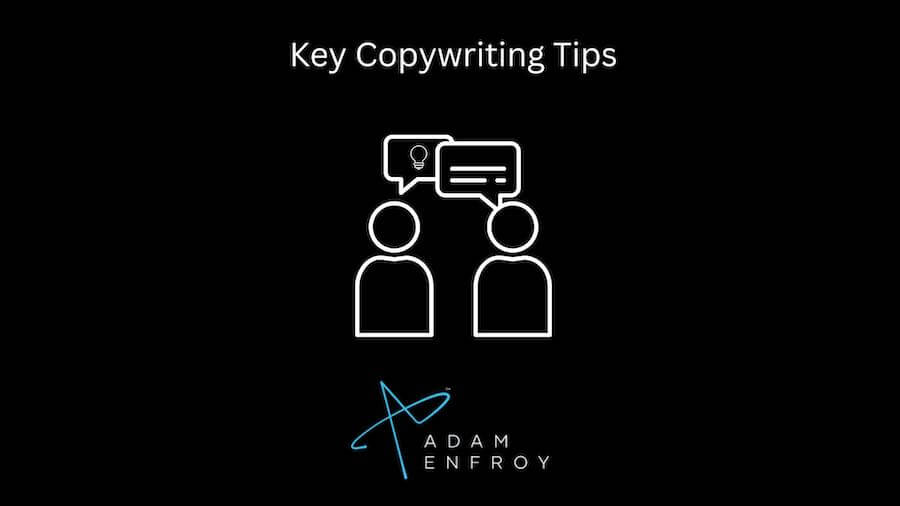
Clarity & Brevity Wins the Day
Sales copywriting requires ad copy to be succinct and engaging to capture readers’ attention.
Each word used must have a purpose—no filler words allowed.
Ensure your message is clear and concise – no one wants to read through pages of dense text, so keep it short yet robust.
Moreover, the best sales copywriters use clear, concise words that do not overwhelm or confuse readers.
As each copywriting job is unique, the writer must carefully consider a customer’s needs and ensure the message is tailored.
Powerful Call-to-Action
No persuasive sales copy would be complete without a powerful call to action at the end.
It’s the final push that can encourage readers to make a purchase or sign up for your service.
The right call to action (CTA) includes triggering a powerful emotion, such as urgency or excitement.
Depending on the format of your content, the CTA can be short, direct, and easy for readers to understand.
A good call-to-action could be the difference between someone checking out your product or service versus just moving on without making a purchase decision.
While the proper templates can help you write compelling copy, it’s up to you (based on your reader’s knowledge) to add the emotional component that motivates them to take action.
Adopt a Conversational Style
When writing copy, it’s essential to adopt a conversational style, like the one you’d use when speaking to a friend.
Your copy should sound more like a conversation than a credit card commercial.
Even if you’re on a more formal platform like LinkedIn, being conversational will engage your audience and encourage them to take the next step.
This tone is vital in a casual sales setting like webinars or podcasts.
A webinar, for example, can come alive when presented in an engaging, comfortable tone that encourages people to participate and take action.
The same applies to podcasts which is often the time for a genuine conversation rather than a one-way monologue.
Emphasize Keywords Using Bullet Points
Another way to ensure your message is heard loud and clear is by emphasizing keywords or phrases with bullet points for easy skimming.
By doing this, you can ensure that the main point of your copy isn’t lost in a sea of text.
Additionally, leaving plenty of whitespace around paragraphs and sentences will help guide readers through your content and keep them engaged.
Whether sending a blast to your email list or posting on social media, bullet points are a great way to ensure your message cuts through the noise in the marketplace.
Speaking of clarity and engagement, keeping sentences short also helps reduce ambiguity and lets readers quickly understand your message.
Tools such as Grammarly or Hemingway App can help determine readability levels.
Writing in an Engaging Tone
When writing sales copy, keep your audience in mind at all times.
Your writing should be tailored to your target audience so that they can identify with it.
Using conversational and engaging language is also essential, as this will help you maintain a connection with the reader throughout your message.
Avoid using jargon and technical terms as much as possible.
Instead, opt for simple words that everyone can understand.
Additionally, using action verbs can make your text more engaging and dynamic, as they create a sense of movement and energy in the text.
For example, in the self-development niche, verbs such as “unlock”, “discover”, and “transform” can help paint a picture of the benefits that your product or service has to offer.
Establishing Credibility
Credibility is essential when writing persuasive sales copy – without it, readers will not trust what you say or believe in your product or service.
To create a sense of trustworthiness in your writing, include social proof such as customer reviews or testimonials from experts who have used your product or service.
You should also back up any claims you make with facts and evidence to add weight to your argument.
Lastly, use authoritative language when talking about yourself and your company.
Doing so will help you become reliable and trustworthy to potential customers.
Wrap Up.
Writing persuasive sales copy is an art form, and following the above tips will get you started when creating engaging and compelling content.
Clear sales copy can help attract more customers and encourage them to purchase your products and services.
Further reading on AdamEnfroy.com: Jasper and Copy AI can help you craft compelling sales copy.
Here’s a direct comparison of these tools, going over how they work, their pros and cons, and more.
If you’re more into content, here’s how to use AI to write ranking articles.
Having the skills to write both content and copy will help you excel in the online sales space and establish your company as an industry leader.




